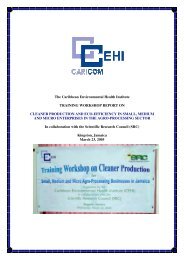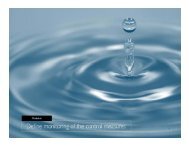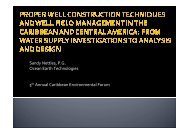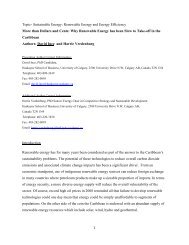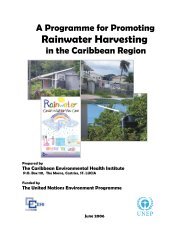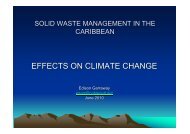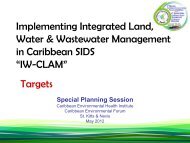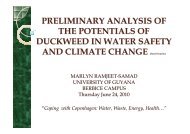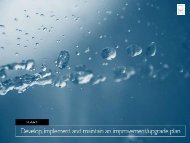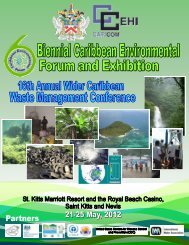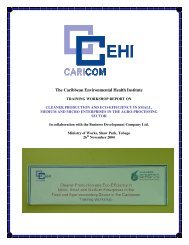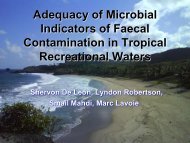conference magazine - Caribbean Environmental Health Institute
conference magazine - Caribbean Environmental Health Institute
conference magazine - Caribbean Environmental Health Institute
Create successful ePaper yourself
Turn your PDF publications into a flip-book with our unique Google optimized e-Paper software.
ventilation, temperature, etc inherent to those room types.<br />
• HosPilot methodology - what the methodology is, how it is<br />
implemented, what technical solutions it proposes and questionnaire<br />
for auditing hospitals<br />
• Description of the pilot sites and their requirements<br />
• The purpose of the project and its intended impact<br />
Assessment of Wastewater Treatment Plants in Jamaica by<br />
the Ministry of <strong>Health</strong> by Nilsia Johnson, Leonard Smith, William<br />
Broughton and Homero Silva<br />
An assessment of the complete status of wastewater treatment<br />
plants (WWTPs), effluent quality and the impact of effluent on the<br />
environment is difficult to make with current data. Therefore it is not<br />
possible to fully determine the compliance by the Government of<br />
Jamaica with the Protocol concerning Pollution from Land-Based<br />
sources and Activities in the Wider <strong>Caribbean</strong> Region (LBS Protocol)<br />
of the Cartagena Convention. The Government of Jamaica<br />
ratified the Cartagena Convention on 1987.<br />
This study aimed to assess the nation’s sewage treatment systems<br />
and their impact on the environment. The objectives were to assess<br />
the efficiency and the effluent water quality of Jamaica’s WWTPs;<br />
Assess the environmental and health impacts of effluents on water<br />
bodies; Assess the level of compliance with the Protocol concerning<br />
Pollution from Land-Based sources and Activities in the Wider<br />
<strong>Caribbean</strong> Region; build the capacity and quality assurance systems<br />
of the Laboratory; and to identify constraints to effective<br />
wastewater treatment and recommend measures for improvement<br />
in the short, medium and long-term.<br />
Regional workshops were conducted to determine the number of<br />
WWTPs. This included discussing the inspection form, schedule of<br />
sampling, methodology and to obtain the GPS coordinates of the<br />
Influent and Effluent of the plant. One sampling exercise was conducted<br />
over a three-month period for each plant, and equipment<br />
and supplies were acquired. Samples were collected for testing of<br />
the effluent and receiving water bodies where applicable for the<br />
following parameters: Faecal Coliform, Biochemical Oxygen Demand<br />
(BOD5), Chemical Oxygen Demand (COD), Nutrients (Total<br />
Nitrate and Total Phosphorus), Oil and Grease and Total Suspended<br />
Solids (TSS). These results were compared with existing<br />
government standards. The compiled data collected was placed on<br />
a national data base.<br />
Preliminary results revealed that there are some wastewater plants<br />
that do not meet the standards. However more information will be<br />
gathered to ensure the consistency of the performance of the<br />
plants.<br />
Analysis of the Nutritional Content of Duckweed and the Quality<br />
of Water that Supports its Growth by Marlyn Ramjeet-Samad<br />
In recent years a commonly occurring aquatic plant, "duckweed"<br />
Lemna sp., has become prominent, because of its ability to concentrate<br />
minerals on heavily polluted water such as that arising from<br />
sewage treatment facilities, intensive animal or crop processing or<br />
production industries. However, it has also attracted the attention of<br />
scientists because of its apparent high potential as a feed resource<br />
for aquaculture and livestock (Skillicorn et al., 1993; Leng, et al.,<br />
1994). Duckweed grows on water with relatively high levels of N, P<br />
and K. It concentrates the minerals and synthesizes protein and<br />
therefore, duckweed can clearly supply the protein needs of aquaculture.<br />
Within recent times and in response to changing environmental<br />
conditions duckweed has been identified as a possible feed source<br />
for aquaculture. This system is being promoted through “increasing<br />
productivity of small farmers by integrating duckweed production<br />
with fish farming”. This project described collectively as Integrated<br />
Farming Systems (IFS), utilizes animal waste to produce biogas via<br />
a bio-digester and the effluent would be used to fertilize duckweed<br />
ponds and the duckweed can then be used to feed aquaculture,<br />
particularly tilapia, poultry and pigs.<br />
When conditions are ideal, in terms of water temperature, pH, incident<br />
light and nutrient concentrations they compete in terms of biomass<br />
production with the most vigorous photosynthetic terrestrial<br />
plants doubling their biomass in between 16 hours and 2 days, depending<br />
on conditions. Baseline data collected from the local environment<br />
reveals that duckweed tissue is 97.5% water and 2.5 % dry<br />
matter, growing well under an average pH of 7.58. The primary<br />
macro nutrients (N, P, K), followed by the secondary macro nutrients<br />
(Mg and Ca) occurred in greater abundance over the micronutrients<br />
and other metals found in the duckweed tissue, indicating the<br />
nutritive quality of duckweed. Also an evaluation of the water quality<br />
that supported the growth of the duckweed discussed above followed<br />
a similar pattern of distribution of minerals namely; primary<br />
macronutrients were in greater abundance, followed by the secondary<br />
macronutrients. This therefore indicated that water quality does<br />
have an influence on the nutritive content of duckweed’s tissue.<br />
It therefore implies that duckweed farming will have a two-fold impact<br />
on environmental sustainability since it reduces the impact<br />
from polluted water by accumulating vital minerals and converting it<br />
to usable forms and secondly by aiding in food security by providing<br />
a cheaper alternative food source for aquaculture and other animals.<br />
The actual application of the duckweed as a food source is<br />
widely promoted in many countries. Therefore, in order to reduced<br />
environmental pollution and enhance food security the duckweed<br />
initiative should be supported.<br />
Proper Well Construction Techniques and Well Field Management<br />
in the <strong>Caribbean</strong> and Central America: From Water Supply<br />
Investigations to Analysis and Design by Sandy Nettles<br />
Ocean Earth Technologies (OET) has been involved in a multitude<br />
of hydrogeologic investigations and well field design projects<br />
throughout the <strong>Caribbean</strong> and Central America. Recently it has<br />
become apparent that water supply shortages and increasing populations,<br />
combined with inefficient well field operation and production<br />
well design, are resulting in serious concerns regarding water supply<br />
throughout the <strong>Caribbean</strong>. Our extensive experience in optimizing<br />
specific wells to maximize their efficiency and longevity in<br />
unique environments has resulted in the successful rehabilitation<br />
and/or design of new water supply systems. OET typically incorporates<br />
geophysical mapping into our full-scale hydrogeologic evalua-<br />
39<br />
A<br />
B<br />
S<br />
T<br />
R<br />
A<br />
C<br />
T<br />
S<br />
FIFTH BIENNIAL CARIBBEAN ENVIRONMENTAL FORUM AND EXHIBITION




